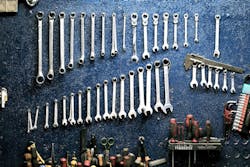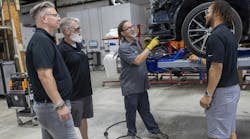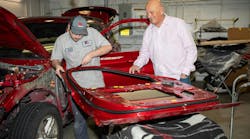Phil O’Connor remembers the days when accounts receivables held up $100,000 per month at his five-location Maine collision business, POC Collision Centers, which generate $10 million in annual revenue. It was a constant stressor and required significant time and effort.
“It’s one of my pet peeves and something we’ve spent a lot of time on,” he says.
That’s why he was determined to find a process that made collecting on money hassle free. Today, thanks to an incentive-based program for his employees, accounts receivables only makes up 15 percent of the shop’s monthly sales.
While O’Connor says shops can take measures to collect the money that is owed to them, in order to reduce accounts receivables, focus needs to be placed on the paperwork process that occurs in the front office. O’Connor shares his steps to best collect on money owed to you.
I track my numbers monthly and have reports sent over from all five locations. A shop should keep money it is owed between 15 percent and 20 percent of the monthly sales. If a shop’s sales are $300,000 per month, then it should have no greater than $60,000 in their accounts receivables.
And shops should collect money within a month or a 40-day time period. For the most part, you’re going to be floating money because repair work is about receiving the check after the work is finished, but at the end of the day, business operates on money, so you need to collect what’s due to you.
Step 1: Educate the Customer on Payment Policy.
To educate the customer on his or her payment options and find out how the shop will be paid, it is important to ask questions.
Ask if the customer has a check from the insurance company and, if he or she does, then we ask if there is a “lien hold” on it. If the lien holder is not signed, then we can’t cash out on it. It inhibits it being a cleared check.
If it is signed, then we discuss the payment. Go over the direction of pay and whether the insurance company or the customer will be paying. Also, offer multiple payment methods. We tell our customers that we accept Visa, Mastercard, a bank check, a certified check or cash. Remember not to accept credit cards for jobs over $1,000 and no personal checks because those are easy to bounce.
Step 2: Reach Out to the Insurance Company.
Immediately have a front-office employee call the customer’s insurance company. We’ll send over the estimate to the insurance company and then someone will call the company right away to make sure it was received. It’s important to get a written confirmation from the insurance company on how and when they will send the check over to the shop.
Step 3: Call Again and Again.
Never let the customer pick up his or her vehicle before the shop has been given the check. Once the front office knows the repairs are done and the car can be scheduled for pickup, then someone needs to call the insurance company and say, “Hey, we worked on this car and the customer is scheduled to pick it up tomorrow.” Make sure the check is sent out before the customer is scheduled to pick up the vehicle.
Step 4: Give Team Incentives.
It’s important to keep the front-office team on top of the accounts. I offer bonuses to the office staff, which are based on the amount of money in accounts receivables. If the numbers are at 90 percent, then I’d be paying out of pocket for the bonuses, so the staff won’t receive them for that month. Unless it’s a low percentage, like 20 percent, the staff won’t receive their bonus.
This way, they’re motivated to keep calling the insurance company and keeping a written record of the money flow.
Step 5: Follow Up Consistently.
Now it’s time to collect the money. To make it easier for the insurance companies to pay, I let some just pay me via direct deposit. We do roughly 60 percent DRP work. For some companies like State Farm, I know they usually pay within 30 days. So, if I’m looking at a lot of money owed to us after 60 days, then I go straight to my front-office team and find out the problem.
If the mistake wasn’t on our end of filing the estimate, then we’ll call the insurance company and say if they don’t pay, we’ll be forced to take them to court. I send a certified letter that the sheriff hand delivers to the insurance company. If the company doesn’t pay within seven days of signing the letter, we take them to small claims court.



